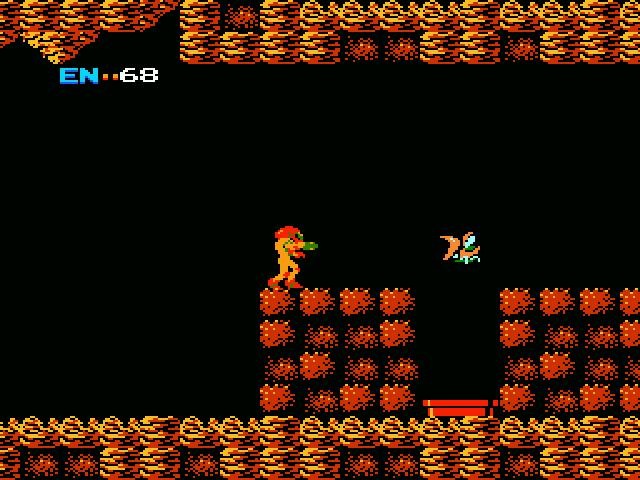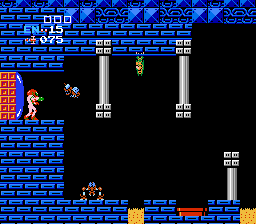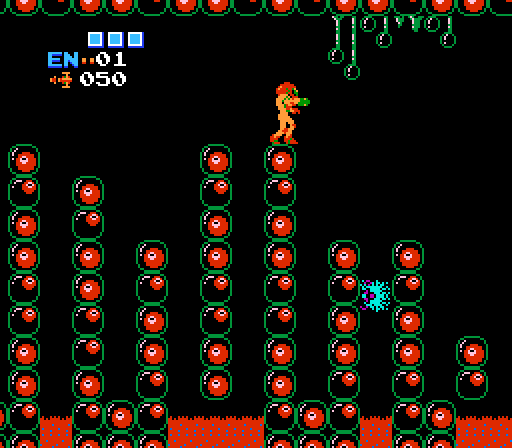
In my last article, I discussed Doom, a landmark game that takes place in a dark future. Doomguy isn’t the first poor soul the video game world has sent into space to deal with a voracious alien threat… in fact, someone else undertook the voyage 7 years earlier, on one of gaming’s iconic consoles.
Her name is Samus Aran, and she is one of the most well-known early female protagonists in video gaming history.

When I was a kid, I admit I wasn’t terribly into Metroid, because I didn’t get how you were supposed to progress through it. I was dense, and I also had kind of a short attention span. Looking back, it deserves all the praise and fan-following it gets. It was unusually advanced in concept for 1986; its gameplay features nonlinear exploration and multiple endings, two ideas that were more or less in their infancy at the time. The Famicom disk version had proper save game slots (think Legend of Zelda style), but the export version (released in ’87) required passwords to resume a previous game. In fact, the password screen could be used to enter certain cheat codes. Another fresh idea implemented was the concept of permanent “powerups.” In games like Super Mario Brothers and other standard platformers of that time, you’d lose a powerup when hurt or it would fade off after a set time. The items you find in Metroid act either as permanent upgrades or modifications, and you keep them once you’ve found them.


In Metroid, Samus Aran must fight her way through the base of some space pirates on the Planet Zebes who have made off with samples of the titular organism. Samus must stop the pirates because Metroids are beings so potentially dangerous that they could be used as weapons of mass destruction, and that’s exactly what the pirates plan to use them for. Little does Samus know that she must eventually face Mother Brain, the alien intelligence directing the pirates’ actions from deep within the planet. Samus must do this alone, but she is a capable combatant and fast on her feet. Based on how quickly you complete the game, you get one of five endings; this gave the game replay value and also nurtured early speed runners by rewarding them in-game. Metroid also focuses primarily on exploration, unlike most of its fellow side-scrollers from that period. You have to backtrack, keep some kind of map (at least mentally), and unlock restricted areas by various means.


At the start of the game, Samus has only a weak pea-shooter of a weapon. However, a diligent search of the surrounding areas will reveal more weapons; your gun gets better, you gain the capacity to shoot missiles, you can roll up into a ball and drop bombs, and then there’s the famous Screw Attack – the somersault that kills. Many of these weapons are also tools – some doors require missiles to open, and you will need to roll up into a ball more than once to get where you need to go. When you destroy an enemy creature, you usually get extra missiles or “energy,” which is tracked as a numerical value and functions as Samus’s “life bar.” The game is fairly gentle on your energy at the beginning, but if you find yourself getting the crap kicked out of you, death is certainly a strong possibility.



At first, you face pretty manageable enemies, like little bugs that cling to walls, slow-flying things that look kind of like fish, and ceiling-clingers that drop predictably down on you. Things do get harder, as not only will the menagerie of alien foes expand, so will the hazards built into the environment. If you see anything that looks like liquid, it will probably hurt you to immerse yourself in it. The two sub-bosses, Kraid and Ridley, are encountered fairly late in the game and are both kind of a joke once you know what to do. If you prepare ahead of time and make sure you’ve got plenty of firepower, you can ace them pretty easily. Mother Brain is a different story. Dealing with her is a two-fold challenge; you must first breach her considerable outer defenses before blasting her into oblivion. Once you’ve defeated Mother Brain, the last challenge is escaping before a timed self-destruct mechanism goes off.

Metroid’s graphics are pretty detailed for their time, with a rich palette and lots of organic/mechanical trade-offs. The sound and music are where the game’s theme really shines through; Hirozaku Tanaka’s soundtrack is appropriately sparse, yet meaningful in the context of the game’s plot. The score was written to emphasize the alien nature of Samus’s surroundings and the sense of isolation one would feel undertaking such a serious mission all alone on a distant, hostile planet like Zebes. The music is arranged so that the deeper you go into the compound, the creepier it gets.
The Metroid series has remained one of the most beloved among Nintendo purists. An entry into the series has been produced for almost every Nintendo system, with the notable exception of the N64 system. The games range from expansions on the original format to attempts at adapting the gameplay to an FPS (first person shooter) style. Samus herself has become one of the company’s most celebrated icons; she is not just lauded for being one of the first female protagonists in a console game, but also simply for being a total badass.

And you know what? Someone had to stop those damned space pirates… why not a badass like Samus Aran?
Stay tuned in August, RetroManiacs! Until next time!



